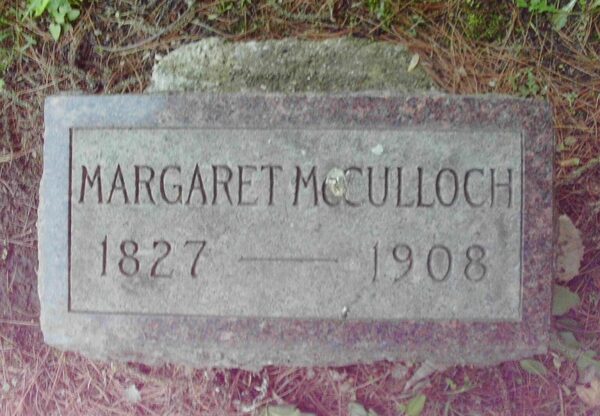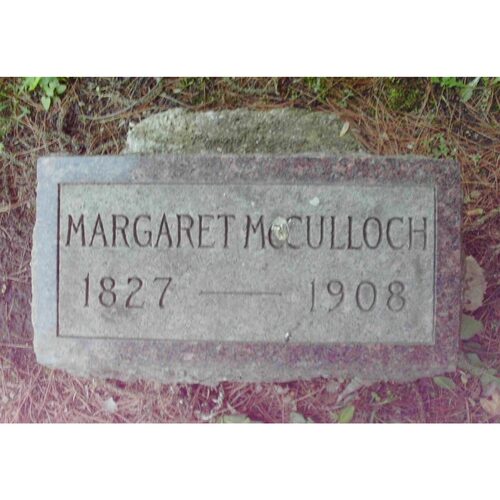
Source: Link
DICKIE, MARGARET (Michener; McCulloch), shoemaker, teacher, telegraph operator, farmer, school inspector, poet, and diarist; b. 4 July 1827 in Half-Way River (Hantsport), N.S., daughter of Samuel Dickie and Sarah (Brothers?); m. first 4 Jan. 1849 Simeon Michener; they had no children; m. secondly 9 April 1856 Robert McCulloch, and they had two daughters; d. 2 Aug. 1908 in Tuscola, Mich.
Margaret Dickie was the daughter of a farmer and shoemaker. At an early age she was taught to stitch soles to the uppers of shoes, a common trade of young women in pre-industrial society. Although detailed evidence is scarce, it is clear that she received a good education from local tutors. Her earliest diaries (1847–48) indicate that she was an active member of the Baptist church, for which she taught Sunday school, kept a lending library, and collected money in aid of its missionary, temperance, educational, and publishing activities. An avid reader of sacred and secular texts, she enjoyed poetry and was herself occasionally inspired by the muse. With her friends and relatives she was an enthusiastic participant in a local singing school, which she described in verse in 1854. Throughout her life she performed time-honoured domestic tasks, whose rhythms are preserved in some detail in her diaries.
On 4 Jan. 1849 Margaret married local mariner Simeon Michener. By the mid 19th century Hantsport was emerging as a major shipbuilding centre and home port for a fleet of sailing ships engaged in a world-wide carrying trade which included the export of gypsum and agricultural products from the Hantsport area. Margaret makes frequent mention in her diary of the building, launching, departure, and arrival of Hantsport vessels. Simeon’s occupation inevitably took him away from home for long periods. It was perhaps because of this forced separation that Margaret decided in the autumn of 1849 to set up a school in her home for local children.
In the spring of 1850 young Hantsport families were attracted by farming opportunities on the Michigan frontier. “We women will be glad to have our husbands give up the seafaring life,” Margaret remarked ruefully in her diary. Ironically, it was the decision to move to the American Midwest that tragically, if temporarily, put an end to Margaret’s dreams of rural domesticity. Simeon died of fever near Chicago in September 1850 while on an exploratory mission for the would-be emigrants.
Margaret continued to teach school following her husband’s death, and was comforted in her grief by the concern and company of relatives and friends. During the winter of 1851–52 she attended Miss Kidson’s academy in nearby Horton in order to further her education. She returned to her various duties in Hantsport, and in 1856 married Irish-born Robert McCulloch, a ship’s caulker. The McCullochs had two daughters, Nettie (b. 1860) and May (b. 1865). Margaret acted for a time as the telegraph operator in Hantsport, and she received an engraving of the Prince of Wales from the telegraph company for her services when the prince visited British North America in 1860.
Following the American Civil War, Margaret’s brother Robert, who was married to Letitia McCulloch (the sister of Margaret’s husband), took his family to Lincoln, Del., where he managed a peach farm. The McCullochs joined the Dickies in July 1867, and together they moved to a farm near Georgetown, Del., in March 1868. In addition to running the households and assisting with farm chores, Margaret taught school for two months, but she gave up the venture because of a lack of students. After a difficult year fraught with illness and hard work, the McCullochs returned to Hantsport in the fall of 1868 and the Dickies moved to Bay City, Mich.
Economic uncertainty in the Maritime shipbuilding industry soon forced the McCulloch family once more to consider emigration, and in 1880 Nettie and her father visited Bay City. Robert McCulloch, now 63 years old, had little difficulty finding work in the Lake Huron shipyards and decided to stay. Margaret and May followed in September 1881. The McCullochs bought a farm near Tuscola and Margaret began the process of sinking roots in new soil. She joined the Baptist church and again became active in ladies’ aid and Sunday school work. She also served as the local school inspector for two terms. When Robert’s health began to fail, Nettie and her husband, James McKay, moved to the Tuscola farm. Margaret gradually resigned her public duties but remained active. Nettie reported that she knitted double mittens for the nearby woollen factory, which “added quite a sum to [her] income.” Nettie also remembered her mother, always an enthusiastic reader, churning butter “with the old fashioned dasher, having a paper pinned to the wall and reading as the work went on.” Robert McCulloch died in 1901 and May, who like her mother had become a teacher, died in 1903. Margaret herself died in 1908, a few weeks after her 81st birthday.
Margaret Dickie’s importance arises primarily from the fact that she kept a diary during significant periods of her adult life. Although the original diaries are no longer extant, excerpts were printed in the Acadian (Wolfville, N.S.) between 1924 and 1930. Her early diaries (1847–52) are unusually rich in information about family and community life in Hantsport; a later diary (originally written in the Graham system of shorthand) chronicles the adventures of the McCullochs in Delaware; and her “Notes by the way” describe the move to Michigan. The diaries reveal the ambitions and mobility of Maritime families in the second half of the 19th century and the adaptability of women like Margaret, who easily integrated the new possibilities of the industrial age into her rural, Baptist culture. Throughout her life Margaret tried her hand at a variety of occupations in several locations, all the while maintaining strong ties with family and community, whose activities she so faithfully recorded.
Excerpts from Margaret Dickie’s diaries covering the periods November 1847–16 Jan. 1848, 13 May 1849–8 Aug. 1852, and 11 July 1867–1 Feb. 1869, and her “Notes by the way,” written from 21 Sept. to 30 Nov. 1881, were published in the Acadian (Wolfville, N.S.) between 1924 and 1930. The following poems by the subject have also been located in the Acadian: “Avonside Cottage or the old red house,” issue of 15 Feb. 1924; “Our singing school,” 6 March 1924; “The storm king,” 11 March 1926; “On the death of Exmouth Davidson, son of Asa and Emily Ann Davidson,” 5 May 1927; and “The Intervale Brook,” 13 Sept. 1928. Her “Minutes of the meeting of the Baptist Ladies’ Aid Society held at Tuscola, Michigan, on 17 January 1895” was reproduced in the issue of 9 March 1929.
Entries from Dickie’s diary covering the period 2 Jan. 1850–4 Jan. 1851 appear in No place like home: diaries and letters of Nova Scotia women, 1771–1938, ed. Margaret Conrad et al. (Halifax, 1988).
Atlantic Baptist Hist. Coll., Acadia Univ. (Wolfville), Hantsport, N.S., United Baptist Church, first minute-book, 1830–55 (typescript). NA, RG 31, C1, 1861, 1871, 1881, Nova Scotia (mfm. at PANS). PANS, MG 5, 7, no.7; RG 1, 448–50. Acadian, 23 Dec. 1923–9 Jan. 1930. Christian Messenger, 16 April 1856, 27 May 1857. C. A. Armour and Thomas Lackey, Sailing ships of the Maritimes . . . 1750–1925 (Toronto and Montreal, 1975). Hattie Chittick, Hantsport on Avon (3rd ed., Hantsport, 1968). J. V. Duncanson, Falmouth – a New England township in Nova Scotia, 1760–1765 (Windsor, Ont., 1965; repr. with supp., Belleville, Ont., 1983). Judith Fingard, Jack in port: sailortowns of eastern Canada (Toronto, 1982). E. W. Sager, Seafaring labour: the merchant marine of Atlantic Canada, 1820–1914 (Kingston, Ont., 1989). G. V. Shand, Historic Hants County (Halifax, 1979).
Cite This Article
Margaret Conrad, “DICKIE, MARGARET (Michener; McCulloch),” in Dictionary of Canadian Biography, vol. 13, University of Toronto/Université Laval, 2003–, accessed December 31, 2025, https://www.biographi.ca/en/bio/dickie_margaret_13E.html.
The citation above shows the format for footnotes and endnotes according to the Chicago manual of style (16th edition). Information to be used in other citation formats:
| Permalink: | https://www.biographi.ca/en/bio/dickie_margaret_13E.html |
| Author of Article: | Margaret Conrad |
| Title of Article: | DICKIE, MARGARET (Michener; McCulloch) |
| Publication Name: | Dictionary of Canadian Biography, vol. 13 |
| Publisher: | University of Toronto/Université Laval |
| Year of publication: | 1994 |
| Year of revision: | 1994 |
| Access Date: | December 31, 2025 |



